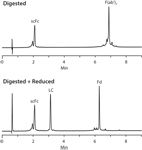BIOshell Fused-Core Columns for Ultra Efficient RPLC of Proteins and Peptides
Columns packed with fully porous particles have long been considered "normal science" for HPLC practitioners. Since 2006, Fused-Core? or core-shell columns have caused a paradigm shift in the minds of liquid chromatographers who analyze small molecules (1).
Columns packed with fully porous particles have long been considered "normal science" for HPLC practitioners. Since 2006, Fused-Core® or core-shell columns have caused a paradigm shift in the minds of liquid chromatographers who analyze small molecules (1). The benefits of porous-shell columns are now also available to scientists who are tasked to advance our knowledge about peptides, proteins and other biopolymers.
Fused-Core HPLC columns are based on the pellicular silica technology developed by J. J. Kirkland at E.I. du Pont de Nemours and Company in the late 1960s during the formative years of HPLC, and applied in this millennium to create ultra-efficient particles in the range of 2.7 to 5 micron (2). The latest innovations derived from this technology are now available as BIOshell™ Fused-Core reversed phase columns for biopolymer separations, featuring 2.7 and 5 micron packed C18 and CN columns for peptides and 3.4 micron packed C4 columns for high efficiency protein separations.
Discussion
In 2007 Supelco introduced the groundbreaking Ascentis® Express Fused-Core columns. Like Ascentis Express columns, BIOshell columns are packed with particles that have a spherical solid glass core surrounded by a thin layer of nano-sized silica particles. To accommodate the larger size of biopolymers, the particles in BIOshell columns either have 160 Å pores, allowing unhindered access for peptides up to mass of about 20 kDa, or 400 Å pores to provide unrestricted diffusion of proteins with a molecular mass up to about 500 kDa. Like Ascentis Express columns for small molecular weight analysis, BIOshell and other columns packed with Fused-Core particles show significantly higher efficiency than columns packed with fully porous particles (3).
The data in Figure 1 demonstrate how BIOshell columns support life science researchers using a so-called middle-down, as opposed to a top-down or bottom-up, approach to analyze the structure of a monoclonal antibody. In a middle-down approach, IgG is fragmented into a few large fragments prior to further characterization. The novel proteolytic enzyme IdeS, commercially available as FabRICATOR®, cleaves an antibody into F(ab')2 and scFc fragments, which have approximate molecular masses of 100 kDa and 25 kDa, respectively. Using disulfide reduction, the F(ab')2 fragment can be further resolved into its light-chain (LC) and F(ab) components. Each of the components in the resulting mixture has a molecular mass of about 25 kDa.

Figure 1: Analysis of antibody fragments after IdeS digestion followed by disulfide reduction. Column: BIOshell A400 Protein C4, 10 cm à 2.1 mm I.D., 3.4 µm; mobile phase A: 80:20, (water, 0.1% TFA):(acetonitrile, 0.1% TFA); mobile phase B: 50:50, (water, 0.1% TFA):(acetonitrile, 0.1% TFA); gradient: 30 to 70% B in 12 min; Flow: 0.3 mL/min; Temp.: 90 °C; UV at 215 nm, injection: 1 µL (sample dilution in mobile phase A).
The top chromatogram shows the simple reversed phase separation of the F(ab')2 and scFc fragments following the digestion of IgG by IdeS, while the bottom trace shows the results following the reduction of F(ab')2 into its LC and F(ab) fragments. Although the analysis time of the separation can be substantially shortened, the narrow widths of the fragments in Figure 1 highlight the important role that BIOshell columns can play in advancing our knowledge about peptides and proteins.
BIOshell is a trademark of Sigma-Aldrich Co LLC and Ascentis is a registered trademark of Sigma-Aldrich Co LLC. FabRICATOR is a registered trademark of Genovis AB. Fused-Core is a registered trademark of Advanced Materials Technology.
References
(1) T.S. Kuhn, The Structure of Scientific Revolutions (Univ. of Chicago Press, LCCN 62019621).
(2) J.J. Kirkland, Superficially Porous Supports for Chromatography, US Patent 3505785.
(3) S. Fekete et al., J. Chrom. A 1236, 177 (2012).

Supelco/Sigma-Aldrich
595 North Harrison Road, Bellefonte, PA 16823
tel. (800) 359-3041, (814) 359-3441
Website: sigma-aldrich.com/analytical

SEC-MALS of Antibody Therapeutics—A Robust Method for In-Depth Sample Characterization
June 1st 2022Monoclonal antibodies (mAbs) are effective therapeutics for cancers, auto-immune diseases, viral infections, and other diseases. Recent developments in antibody therapeutics aim to add more specific binding regions (bi- and multi-specificity) to increase their effectiveness and/or to downsize the molecule to the specific binding regions (for example, scFv or Fab fragment) to achieve better penetration of the tissue. As the molecule gets more complex, the possible high and low molecular weight (H/LMW) impurities become more complex, too. In order to accurately analyze the various species, more advanced detection than ultraviolet (UV) is required to characterize a mAb sample.

.png&w=3840&q=75)

.png&w=3840&q=75)



.png&w=3840&q=75)



.png&w=3840&q=75)














